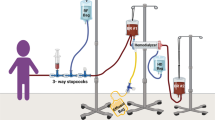Abstract
An electrical or water supply and a blood purification machine are required for renal replacement therapy. There is a possibility that acute kidney injury can occur in large numbers and on a wide scale in the case of a massive earthquake, and there is the potential risk that the current supply will be unable to cope with acute kidney injury cases. However, non-machinery dialysis requires exclusive circuits and has the characteristic of not requiring the full-scale dialysis machines. We performed perfusion experiments that used non-machinery dialysis and recent blood purification machines in 30-min intervals, and the effectiveness of non-machinery dialysis was evaluated by the assessing the removal efficiency of potassium, which causes lethal arrhythmia during acute kidney injury. The non-machinery dialysis potassium removal rate was at the same level as continuous blood purification machines with a dialysate flow rate of 5 L/h after 15 min and continuous blood purification machines with a dialysate flow rate of 3 L/h after 30 min. Non-machinery dialysis required an exclusive dialysate circuit, the frequent need to replace bags, and new dialysate exchanged once every 30 min. However, it can be seen as an effective renal replacement therapy for crush-related acute kidney injury patients, even in locations or facilities not having the full-scale dialysis machines.





Similar content being viewed by others
References
Bartels SA, VanRooyen MJ. Medical complications associated with earthquakes. Lancet. 2012;379:748–57.
Sever MS, Vanholder R, Lameire N. Management of crush-related injuries after disasters. N Engl J Med. 2006;354:1052–63.
Ronco C. Rethinking acute dialysis strategies in major disasters: new perspectives and future directions suggested by the Haitian earthquake. Blood Purif. 2010;29:329–30.
He P, Zhou C, Li H, et al. A portable continuous blood purification machine for emergency rescue in disasters. Blood Purif. 2012;33:227–37.
Uchita K, Abe T, Ohira S, et al. Development of a dialysis system using no machine (non machinery dialysis). J Jpn Soc Dial Ther. 1986;19:745–50. (Japanese with English summary).
Miki S, Yuasa S, Takamitsu Y. CAVNMD (continuous arterovenous non machinery dialysis) treatment of renal failure in patients with serious disease. Jpn J Artif Organs. 1987;16:758–61. (Japanese with English summary).
Uchita K, Kobata H, Ebisu T, et al. Features and indications of various methods of continuous renal replacement therapy. J Jpn Soc Dial Ther. 1990;23:377–82. (Japanese with English summary).
Uehara H, Shiohira Y, Sunagawa H et al. Non-machinery dialysis. Nihon Rinsho. 1991;49:377–81. (article in Japanese).
Oda Y, Shindoh M, Yukioka H et al. Crush syndrome sustained in the 1995 Kobe, Japan, earthquake; treatment and outcome. Ann Emerg Med 1997;30:507–12.
Akabayashi A, Kodama S. Lessons from Japan’s March 2011 earthquake regarding dialysis patients. Ther Apher Dial. 2011;15:334.
Tsubokura M, Horie S, Komatsu H, et al. The impact of the Great Tohoku Earthquake on the dialysis practice in the disaster-stricken area. Hemodial Int. 2012;16:320–21.
Nangaku M, Akizawa T. Diary of a Japanese nephrologist during the present disaster. Kidney Int. 2011;79:1037–9.
Sever MS, Lameire N, Van Biesen W, et al. Disaster nephrology: a new concept for an old problem. Clin Kidney J. 2015;8:300–9.
The Japan Times. Up to 23,000 may die in major Tokyo inland quake: government prediction. http://www.japantimes.co.jp/news/2013/12/19/national/up-to-23000-may-die-in-major-tokyo-inland-quake-government-prediction/#.VygpDodf2rw. Accessed 1 Aug 2016.
Gibney RT, Sever MS, Vanholder RC. Disaster nephrology: crush injury and beyond. Kidney Int. 2014;85:1049–57.
Gray NA, Wolley M, Liew A, et al. Natural disasters and dialysis care in the Asia-Pacific. Nephrology. 2015;20:873–80.
Kramer P, Schrader J, Bohnsack W, et al. Continuous arteriovenous haemofiltration. A new kidney replacement therapy. Proc Eur Dial Transplant Assoc. 1981;18:743–9.
Author information
Authors and Affiliations
Corresponding author
Ethics declarations
Conflict of interest
The authors declare that there are no conflicts of interest.
Rights and permissions
About this article
Cite this article
Abe, T., Onoda, M., Matsuura, T. et al. Non-machinery dialysis that achieves blood purification therapy without using full-scale dialysis machines. J Artif Organs 20, 230–235 (2017). https://doi.org/10.1007/s10047-017-0953-x
Received:
Accepted:
Published:
Issue Date:
DOI: https://doi.org/10.1007/s10047-017-0953-x




